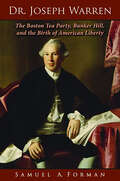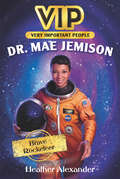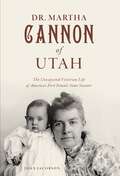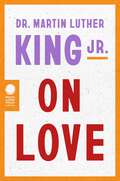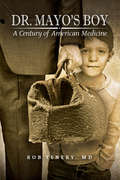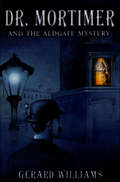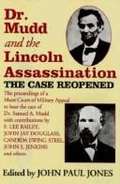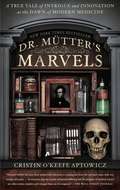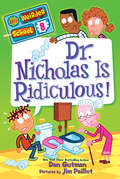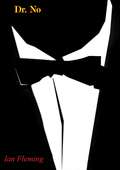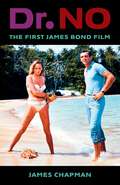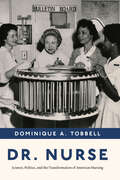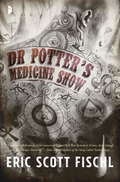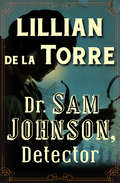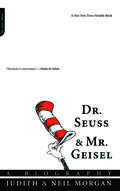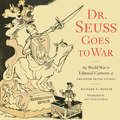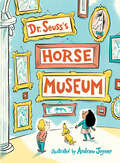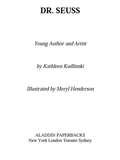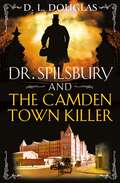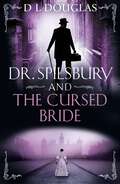- Table View
- List View
Dr. Joseph Warren: The Boston Tea Party, Bunker Hill, and the Birth of American Liberty
by Sam FormanMeticulously grounded in original scholarship, this ambitious project is the definitive biography of Dr. Joseph Warren. Making sense of the subject's opaque eighteenth-century physician's account books was a feat of both forensic analysis and medical historical scholarship. It was also the elusive key to understanding Joseph Warren's life experiences. Scholar-physician Samuel A. Forman has used his capabilities in history, medicine, and business accounting combined with his enthusiasm for the topic to produce a volume worthy of its subject. During the American Revolution, Dr. Joseph Warren was a nationally known figure. A Boston physician and hero of the Battle of Bunker Hill, he became known for his unconventional exploits in medicine. His hobby of obtaining dead bodies for anatomical study was picked up by the Harvard Spunkers Club, the forerunner of Harvard University's Medical School. Later, when Warren was running his own practice, he was allegedly heading up a spy ring out of his office. It was even rumored that he had an affair with the wife of an enemy general in order to collect military intelligence. Other newly proved information about him is recorded in the book's illuminating appendices, from personal associations to the truth behind the legend that his head was previously held on display.
Dr. Livingstone, I Presume?: Missionaries, Journalists, Explorers, And Empire
by Clare PettittWhen the American reporter Henry Morton Stanley stepped out of the jungle in 1871 and doffed his pith helmet to the Scottish missionary-explorer Dr. David Livingstone, his greeting was to take on mythological proportions. But do any of us really know what his words meant at the time--and what they have come to mean since? Far from meeting in a remote thicket in "Darkest Africa," Stanley met Livingstone in the middle of a thriving Muslim community. The news of their encounter was transmitted around the globe, and Livingstone instantly became one of the world's first international celebrities. This book shows how urgently a handshake between a Briton and an American was needed to heal the rift between the two countries after the American Civil War. It uncovers for the first time the journeys that Livingstone's African servants made around Britain after his death, and it makes a case for Stanley's immense influence on the idea of the modern at the dawn of the twentieth century. Drawing on films, children's books, games, songs, cartoons, and TV shows, this book reveals the many ways our culture has remembered Stanley's phrase, while tracking the birth of an Anglo-American Christian imperialism that still sets the world agenda today. ""Dr. Livingstone, I Presume?"" is a story of conflict and paradox that also takes us into the extraordinary history of British engagement with Africa. Clare Pettitt shows both the bleakest side of imperialism and the strange afterlife of a historical event in popular mythmaking and music hall jokes.
Dr. Mae Jemison: Brave Rocketeer (VIP #2)
by Heather AlexanderSoar to the stars with Dr. Mae Jemison in this exciting middle grade nonfiction biography. Perfect for fans of the Who Was and Little Leaders series, the books in the VIP series tell the true—and amazing—stories of some of history's greatest trailblazers. Meet the VERY IMPORTANT PEOPLE who changed the world! <p><p>Mae Jemison is the first African American woman to travel to space. She’s also a medical doctor who once joined the Peace Corps. And a trained dancer, too! Experience all the exciting moments in Dr. Jemison's thrilling life in this exciting biography, packed with two-color illustrations and fun facts, including the secrets of NASA. <p><p>Short and engaging chapters are interspersed with special lists and other information made to order to engage kids, whether they're already biography fans or "have to" write a report for school. <p><p>The special sections in VIP: Dr. Mae Jemison include "Answers to Some Big Questions Mae Wondered About"; "10 Things Women Couldn’t Do in the 1960s and 1970s"; and "QUIZ: Do You Have What It Takes to Be an Astronaut?"The VIP series features inspiring adventures and fun facts about some of history's greatest trailblazers—smart, tough, persevering innovators who will inspire today's kids. <p><p>Featuring underappreciated historical figures and groups, with a focus on leaders in science and technology, the nonfiction biographies in the VIP series are fun and engaging. Just looking at the cover will make kids want to learn more about these VIPs, and once they dive in they will zoom through stories that read like adventures. <p><p>Each book in the VIP series allows your middle grader to experience all the exciting moments in some very important but lesser known lives.
Dr. Martha Cannon of Utah: The Unexpected Victorian Life of America’s First Female State Senator (The History Press)
by Joan JacobsonPrudery, Polygamy and Politics Dr. Martha Hughes Cannon was no hands-on-the-plow pioneer. She was no stereotypical polygamous wife. Nor was she a prim lady who blushed at the word "legs." Victorian Mormons were proud to lead the way in empowering women. "Verily the world progresseth," exclaimed the Deseret Evening News on March 17, 1869, celebrating a Congressional bill to give Utah women the vote. But the federal intention to have female suffrage in Utah destroy polygamy failed. The 1882 Edmunds Act made "cohabitation" a felony. To protect her polygamous husband, she fled to England with their infant daughter. Upon her return, she reestablished her medical practice and opened Utah's first training school for nurses. Nominated by local Democrats, Mattie ran against her husband for state senate in 1896 - beating him by four thousand votes. Author Joan Jacobson chronicles an extraordinary life remarkably relevant for today.
Dr. Martin Luther King Jr. on Love
by Dr. Martin Luther King Jr.A remarkable compilation of Dr. Martin Luther King Jr.’s reflections on love and its transformative power—a stellar addition to Dr. King’s archives published exclusively by HarperCollins.“I have also decided to stick with love for I know that love is ultimately the only answer to mankind’s problems.”—Martin Luther King Jr.Dr. King, one of the greatest civil rights leaders in history, wrote and reflected frequently about love. He understood its transformative power and the essential role love played in his mission as the catalyst for positive change.Now for the first time, in this project of the Dr. King archives published exclusively by HarperCollins, readers will get access to many of King’s writings on love—compiled in a deeply insightful, moving and transformative work of literature. Each section of the book is accompanied by brief introductory editorial remarks that reflect on the historical context of each speech, sermon, and piece of writing, and will further enrich the reader's understanding and appreciation of Dr. King's timeless wisdom.Love is explored, championed, and debated around the world. It is the central concern of many religious practices. Readers are deeply curious about its nature. C.S. Lewis' The Four Loves, Thich Nhat Hanh's How To Love, or even bell hooks' All About Love showcase that readers and writers share this universal longing and fascination to uncover love’s mysteries.This book represents the first volume in an "On" series from the MLK archives, featuring MLK on various subjects. By grouping his work by subject, readers will get a glimpse at the evolution of his ideas and understand the circumstances in which that theme emerged to lead his concerns.
Dr. Mayo's Boy: A Century of American Medicine
by Rob TeneryAn ophthalmologist recounts the lives and experiences of three generations of doctors in America, revealing changes in health care.Dr. Mayo&’s Boy chronicles the medical experiences of a family of Texas physicians in small town Waxahachie and big city Dallas. Full of stories that are often heartening in their humanity and sometimes disturbing in what they reveal about contemporary health care, this book explores how physicians have viewed their commitment to their patients, how they sacrificed to meet the challenges they face, and how the practice of medicine has changed over almost sixty years. While Dr. Mayo&’s Boy is by no means a policy statement, it does offer a nostalgic but clear-eyed look at the past and, through its tales of three doctors&’ lives, asks implicit questions about how we &“manage&” health care today. There must remain one constant—the need for a patient to know that their doctor cares about them as an individual.Praise for Dr. Mayo&’s Boy&“An extraordinary book. Rob Tenery traces the evolution of health care in this country and show how much medicine has gained—and lost—in the past hundred years. In a highly entertaining and eloquent way, Dr. Tenery makes a plea for medicine to return to its roots as a healing profession rather than as a business. Highly recommended!&” —Dean Ornish, MD, founder and president of the Preventative Medicine Research Institute, University of California, San Francisco
Dr. Mortimer and the Aldgate Mystery
by Gerard WilliamsSet amid the clip and clatter of hansom cabs and the popping of the gaslights, this intriguing mystery introduces Dr. James Mortimer, the man who brought the case of the Hound of the Baskervilles to the attention of Sherlock Holmes. Here, Dr. Mortimer tells a tale of how he came across his second and most challenging case ever.In 1890, the young Dr. Mortimer is numb with grief over the death of his wife and decides to close his own practice and begin a new life for himself. He winds up in London and is asked to fill in for another doctor with an emergency. Dr. Mortimer agrees and his last call of the day brings him to an address in Aldgate where he meets the captivating Lavinia Nancarrow. Intrigued and worried by the overbearing solicitude of the girl's guardian who keeps her a virtual prisoner, Mortimer determines to discover the reasons behind Lavinia's confinement.Engagingly absent-minded but incessantly curious and observant, Mortimer is aided in his effort by his formidable consort, the liberated Dr. Violet Branscombe. Together they unravel a mystery as dark and sinister as the East End Alleys of Victorian London. A retired Calcutta merchant with a guilty secret, a decadent fin-de-siecle artist who frequents an anarchist café in Whitechapel and a seemingly impossible murder are the key pieces in the puzzle, which Mortimer soon finds himself trying to solve, in Gerard Williams's Dr. Mortimer and the Aldgate Mystery.
Dr. Mudd and the Lincoln Assassination: The Case Reopened
by John Paul Jones(book flaps) On June 30, 1865, Samuel A. Mudd was convicted of conspiring with John Wilkes Booth and others to assassinate President Abraham Lincoln. He was sentenced to life imprisonment on an island off the coast of Florida. Dr. Mudd was pardoned in 1869 by President Andrew Johnson, based on his assistance in a yellow fever epidemic rather than on the merits of his case, leaving unresolved until the present day the question of his ultimate guilt or innocence. On February 12, 1993, the University of Richmond School of Law convened a distinguished group of jurists and Civil War historians to thoroughly present both sides of the case of Samuel Mudd and the broader Lincoln Conspiracy before a panel of judges in an actual courtroom. Dr. Mudd was represented by F. Lee Bailey, Attorney at Law and former Marine fighter pilot and legal officer; and Candida Ewing Staempfli Steel, Attorney at Law and greatgreat-granddaughter of General Thomas Ewing, Dr. Mudd's original counsel. The government was represented by John Jay Douglass, Dean of the National College of District Attorneys and former Commandant of the Judge Advocate General's School; and Admiral John S. Jenkins, Associate Dean and Lecturer at the George Washington University National Law Center, and former Judge Advocate General of the U.S. Navy. The attorneys presented their arguments with all the detail and color of a modern legal case. Dr. Mudd and the Lincoln Assassination is the complete record of the proceedings, with added commentary by distinguished historians. Some scholars argue that Mudd was completely innocent, while others cite eyewitness reports of seeing Mudd in the company of John Wilkes Booth in Washington prior to the assassination. In Dr. Mudd and the Lincoln Assassination the legality of the military tribunal that tried Mudd is both defended and attacked in fascinating detail. This volume combines the drama of the Civil War with the suspense of a modern trial and contains a wealth of detail on the Lincoln Conspiracy, much of it unknown to the general public. Dr. Mudd contains the complete text of recent decisions by the U.S. Court of Military Appeals and other bodies in the matter of Samuel Mudd, a case still pending in U.S. courts. The main text is backed up by extensive references for further reading, few of which normally appear in Civil War books.
Dr. Mutter's Marvels
by Cristin O'Keefe AptowiczA mesmerizing biography of the brilliant and eccentric medical innovator who revolutionized American surgery and founded the country's most famous museum of medical oddities Imagine undergoing an operation without anesthesia performed by a surgeon who refuses to sterilize his tools--or even wash his hands. This was the world of medicine when Thomas Dent Mütter began his trailblazing career as a plastic surgeon in Philadelphia during the middle of the nineteenth century. Although he died at just forty-eight, Mütter was an audacious medical innovator who pioneered the use of ether as anesthesia, the sterilization of surgical tools, and a compassion-based vision for helping the severely deformed, which clashed spectacularly with the sentiments of his time. Brilliant, outspoken, and brazenly handsome, Mütter was flamboyant in every aspect of his life. He wore pink silk suits to perform surgery, added an umlaut to his last name just because he could, and amassed an immense collection of medical oddities that would later form the basis of Philadelphia's Mütter Museum. Award-winning writer Cristin O'Keefe Aptowicz vividly chronicles how Mütter's efforts helped establish Philadelphia as a global mecca for medical innovation--despite intense resistance from his numerous rivals. (Foremost among them: Charles D. Meigs, an influential obstetrician who loathed Mütter's "overly" modern medical opinions.) In the narrative spirit of The Devil in the White City, Dr. Mütter's Marvels interweaves an eye-opening portrait of nineteenth-century medicine with the riveting biography of a man once described as the "P. T. Barnum of the surgery room."
Dr. Nicholas Is Ridiculous! (My Weirder School #8)
by Dan GutmanMy Weirder School weirder than ever Dr. Nicholas is the weirdest history teacher in history She doesnt care about wars and presidents. She is going to teach the kids about the history of the toilet bowl Is she crazy? She built a time machine so she can take the kids into the past . . . and the future. Guess whos going to get stuck in time?
Dr. No (Coronet Bks. #6)
by Ian FlemingIt was a naked girl, with her back to him. She was not quite naked. She wore a broad leather belt round her waist with a hunting knife in a leather sheath at her right hip. The belt made her nakedness extraordinarily erotic. She stood not more than five yards away on the tideline looking down at something in her hand. She stood in the classical relaxed pose of the nude, all the weight on the right leg and the left knee bent and turning slightly inwards, the head to one side as she examined the things in her hand.M called this case a soft option. Bond can’t quite agree. The tropical island is luxurious, the seductive Honey Rider is beautiful and willing.But they are both part of the empire of Dr. No.The doctor is a worthy adversary, with a mind as hard and cold as his solid steel hands.Dr. No’s obsession is power. His only gifts are strictly pain-shaped.‘Masterful...beautifully written.’—Raymond Chandler, The Sunday Times.‘The essence of a James Bond thriller is its speed, its knowingness...Dr. No has a full quota of every ingredient. Bond is better than ever.’—Evening Standard.‘Wildly thrilling, packed with convincing technical detail.’—C. Day Lewis, BBC World of Books.‘Pace, brilliant descriptive powers, superb imagination...sheer entertainment.’—Spectator.
Dr. No: The First James Bond Film
by James ChapmanWhen Dr. No premiered at the London Pavilion on October 5, 1962, no one predicted that it would launch the longest-running series in cinema history. It introduced the James Bond formula that has been a box-office fixture ever since: sensational plots, colorful locations, beautiful women, diabolical villains, thrilling action set pieces, and a tongue-in-cheek tone. An explosive cocktail of action, spectacle, and sex, Dr. No transformed popular cinema.James Chapman provides a lively and comprehensive study of Dr. No, marshaling a wealth of archival research to place the film in its historical moment. He demonstrates that, contrary to many fan myths, the film was the product of a carefully considered transnational production process. Chapman explores the British super-spy’s origins in Ian Fleming’s snobbery-with-violence thrillers, examining the process of adaptation from page to screen. He considers Dr. No in the contexts of the UK and Hollywood film industries as well as the film’s place in relation to the changing social and cultural landscape of the 1960s, particularly Cold War anxieties and the decline of the British Empire. The book also analyzes the film’s problematic politics of gender and race and considers its cultural legacy.This thorough and insightful account of Dr. No will appeal to film historians and Bond fans alike.
Dr. Nurse: Science, Politics, and the Transformation of American Nursing
by Dominique A. TobbellAn analysis of the efforts of American nurses to establish nursing as an academic discipline and nurses as valued researchers in the decades after World War II. Nurses represent the largest segment of the U.S. health care workforce and spend significantly more time with patients than any other member of the health care team. Dr. Nurse probes their history to examine major changes that have taken place in American health care in the second half of the twentieth century. The book reveals how federal and state health and higher education policies shaped education within health professions after World War II. Starting in the 1950s, academic nurses sought to construct a science of nursing—distinct from that of the related biomedical or behavioral sciences—that would provide the basis for nursing practice. Their efforts transformed nursing’s labor into a valuable site of knowledge production and proved how the application of their knowledge was integral to improving patient outcomes. Exploring the knowledge claims, strategies, and politics involved as academic nurses negotiated their roles and nursing’s future, Dr. Nurse highlights how state-supported health centers have profoundly shaped nursing education and health care delivery.
Dr. Nurse: Science, Politics, and the Transformation of American Nursing
by Dominique A. TobbellAn analysis of the efforts of American nurses to establish nursing as an academic discipline and nurses as valued researchers in the decades after World War II. Nurses represent the largest segment of the U.S. health care workforce and spend significantly more time with patients than any other member of the health care team. Dr. Nurse probes their history to examine major changes that have taken place in American health care in the second half of the twentieth century. The book reveals how federal and state health and higher education policies shaped education within health professions after World War II. Starting in the 1950s, academic nurses sought to construct a science of nursing—distinct from that of the related biomedical or behavioral sciences—that would provide the basis for nursing practice. Their efforts transformed nursing’s labor into a valuable site of knowledge production and proved how the application of their knowledge was integral to improving patient outcomes. Exploring the knowledge claims, strategies, and politics involved as academic nurses negotiated their roles and nursing’s future, Dr. Nurse highlights how state-supported health centers have profoundly shaped nursing education and health care delivery.
Dr. Nurse: Science, Politics, and the Transformation of American Nursing
by Dominique A. TobbellAn analysis of the efforts of American nurses to establish nursing as an academic discipline and nurses as valued researchers in the decades after World War II. Nurses represent the largest segment of the U.S. health care workforce and spend significantly more time with patients than any other member of the health care team. Dr. Nurse probes their history to examine major changes that have taken place in American health care in the second half of the twentieth century. The book reveals how federal and state health and higher education policies shaped education within health professions after World War II. Starting in the 1950s, academic nurses sought to construct a science of nursing—distinct from that of the related biomedical or behavioral sciences—that would provide the basis for nursing practice. Their efforts transformed nursing’s labor into a valuable site of knowledge production and proved how the application of their knowledge was integral to improving patient outcomes. Exploring the knowledge claims, strategies, and politics involved as academic nurses negotiated their roles and nursing’s future, Dr. Nurse highlights how state-supported health centers have profoundly shaped nursing education and health care delivery.
Dr. Potter's Medicine Show
by Eric Scott FischlThe year is 1878. Dr Alexander Potter, disgraced Civil War surgeon, now snake-oil salesman, travels the Pacific Northwest with a disheartened company of strongmen, fortune-tellers, and musical whores. Under their mysterious and murderous leader they entertain the masses while hawking the Chock-a-saw Sagwa Tonic, a vital elixir touted to cure all ills both physical and spiritual. For a few unfortunate customers, however, the Sagwa offers something much, much worse.For drunken dentist Josiah McDaniel, the Sagwa has taken everything from him; in the hired company of two accidental outlaws, the bickering brothers Solomon Parker and Agamemnon Rideout, he looks to revenge himself on the Elixir’s creator: Dr. Morrison Hedwith, businessman, body-thief, and secret alchemist, a man who is running out of time.File Under: Fantasy [ The Secret Tradition | Chemical Imbalance | Hustlers Hustled | The Carnival is Over ]
Dr. Sam Johnson, Detector: As Told By James Boswell (The Dr. Sam Johnson Mysteries #1)
by Lillian de la TorreNine mystery tales starring lexicographer Dr. Samuel Johnson in &“the finest series of historical detective stories ever written&” (Ellery Queen). For over two hundred years, devotees of English literature have lost themselves in James Boswell&’s Life of Johnson, a biography of the great eighteenth-century thinker and writer, chronicling everything from kitchen chemistry experiments to tackling a pickpocket to his legendary investigation of the Cock Lane ghost. But Dr. Sam Johnson was more than a great thinker—he was also a talented sleuth. From the chilling affair of the waxwork cadaver to the thrilling search for the stolen seal of England, the nine cases in this volume show Johnson at his very best—using his legendary intellect to apprehend the worst killers and thieves the era had to offer. Written by Lillian de la Torre, a mystery author with &“a finely tuned ear for eighteenth-century prose,&” these charming stories are so believable, so perfectly in keeping with the Dr. Johnson we know and love, it&’s hard to believe they aren&’t true (TheNew York Times).
Dr. Seuss & Mr. Geisel: A Biography
by Judith Morgan Neil MorganHorton, Thidwick, Yertle, the Lorax, the Grinch, Sneetches, and the Cat in the Hat are just a handful of the bizarre and beloved characters Theodor S. Geisel (1904-1991), alias Dr. Seuss, created in his forty-seven children's books, from 1937's And to Think That I Saw It on Mulberry Street to 1990's Oh, the Places You'll Go! During his lifetime Dr. Seuss was honored with numerous degrees, three Academy Awards, and a Pulitzer, but the man himself remained a reclusive enigma. In this first and only biography of the good doctor, the authors, his close friends for almost thirty years, have drawn on their firsthand insights as well as his voluminous papers; the result is an illuminating, intimate portrait of a dreamer who saw the world "through the wrong end of a telescope," and invited us to enjoy the view.
Dr. Seuss Goes to War: The World War II Editorial Cartoons of Theodor Seuss Geisel
by Richard H. Minear&“A fascinating collection&” of wartime cartoons from the beloved children&’s author and illustrator (The New York Times Book Review). For decades, readers throughout the world have enjoyed the marvelous stories and illustrations of Theodor Seuss Geisel, better known as Dr. Seuss. But few know the work Geisel did as a political cartoonist during World War II, for the New York daily newspaper PM. In these extraordinarily trenchant cartoons, Geisel presents &“a provocative history of wartime politics&” (Entertainment Weekly). Dr. Seuss Goes to War features handsome, large-format reproductions of more than two hundred of Geisel&’s cartoons, alongside &“insightful&” commentary by the historian Richard H. Minear that places them in the context of the national climate they reflect (Booklist). Pulitzer Prize–winner Art Spiegelman&’s introduction places Seuss firmly in the pantheon of the leading political cartoonists of our time. &“A shocker—this cat is not in the hat!&” —Studs Terkel
Dr. Seuss and Mr. Geisel
by Judith Morgan Neil MorganHorton, Thidwick, Yertle, the Lorax, the Grinch, Sneetches, and the Cat in the Hat are just a handful of the bizarre and beloved characters Theodor S. Geisel (1904-1991), alias Dr. Seuss, created in his forty-seven children's books, from 1937's And to Think That I Saw It on Mulberry Street to 1990's Oh, the Places You'll Go! During his lifetime Dr. Seuss was honored with numerous degrees, three Academy Awards, and a Pulitzer, but the man himself remained a reclusive enigma. In this first and only biography of the good doctor, the authors, his close friends for almost thirty years, have drawn on their firsthand insights as well as his voluminous papers; the result is an illuminating, intimate portrait of a dreamer who saw the world "through the wrong end of a telescope," and invited us to enjoy the view.
Dr. Seuss's Horse Museum (Classic Seuss)
by Dr. SeussThis #1 New York Times bestseller is the perfect gift for the young artist in your life! A never-before-published Dr. Seuss non-fiction book about creating and looking at art! Based on an unrhymed manuscript and sketches discovered in 2013, this book is like a visit to a museum—with a horse as your guide! Explore how different artists have seen horses, and maybe even find a new way of looking at them yourself. Discover full-color photographic art reproductions of pieces by Picasso, George Stubbs, Rosa Bonheur, Alexander Calder, Jacob Lawrence, Deborah Butterfield, Franz Marc, Jackson Pollock, and many others—all of which feature a horse! Young readers will find themselves delightfully transported by the engaging equines as they learn about the creative process and how to see art in new ways. Taking inspiration from Dr. Seuss&’s original sketches, acclaimed illustrator Andrew Joyner has created a look that is both subtly Seussian and wholly his own. His whimsical illustrations are combined throughout with &“real-life&” art. Cameo appearances by classic Dr. Seuss characters (among them the Cat in the Hat, the Grinch, and Horton the Elephant) make Dr. Seuss&’s Horse Museum a playful picture book that is totally unique. Ideal for home or classroom use, it encourages critical thinking and makes a great gift for Seuss fans, artists, and horse lovers of all ages. Publisher&’s Notes discuss the discovery of the manuscript and sketches, Dr. Seuss&’s interest in understanding modern art, the process of creating the book, and information about each of the artists and art reproductions in the book.
Dr. Seuss: Young Author and Artist (Childhood of Famous Americans Series)
by Kathleen V. KudlinskiBorn in Springfield, Massachusetts, Theodor Seuss Geisel (1904-1991) was destined to grow up to become the most beloved, bestselling children's book writer of all time. This biography explores the events of his childhood. Illustrations.
Dr. Spilsbury and the Camden Town Killer
by D.L. DouglasDr. Spilsbury and the Camden Town Killer is the first in an exciting new historical mystery series, featuring legendary forensic pathologist Sir Bernard Henry Spilsbury London, 1920. There's a killer on the streets of Camden Town, and no woman is safe.When a woman's body is dragged from the Regent's Canal on a freezing January night, eminent forensic pathologist and criminal sleuth Dr Bernard Spilsbury immediately detects foul play. And when a second woman washes up dead under similar circumstances, police realise they are looking for a dangerous predator. Is someone luring lonely spinsters to their deaths through a newspaper Lonely Hearts column? And can they be stopped before they strike again? With time against them, there's only one thing the police can do... Send for Dr Spilsbury!
Dr. Spilsbury and the Cursed Bride: The BRAND NEW unputdownable title in the gripping Dr Spilsbury series
by D.L. DouglasShe kept her gaze fixed out of the window, towards the village and Withington Hall beyond. 'It's perfect,' she said...September 1920. A young bride is discovered dead at a country house on her wedding day. Has she fallen victim to the deadly Withington curse, which strikes down any woman who marries into the family?Forensic Pathologist Dr Bernard Spilsbury doesn't believe in such superstitions, and suspects a more earthly reason for Theodora Tupper's death. But as he and his trusty assistant Violet investigate, they soon discover that there are indeed ghosts at Withington Hall. And they, too, have a story to tell...
